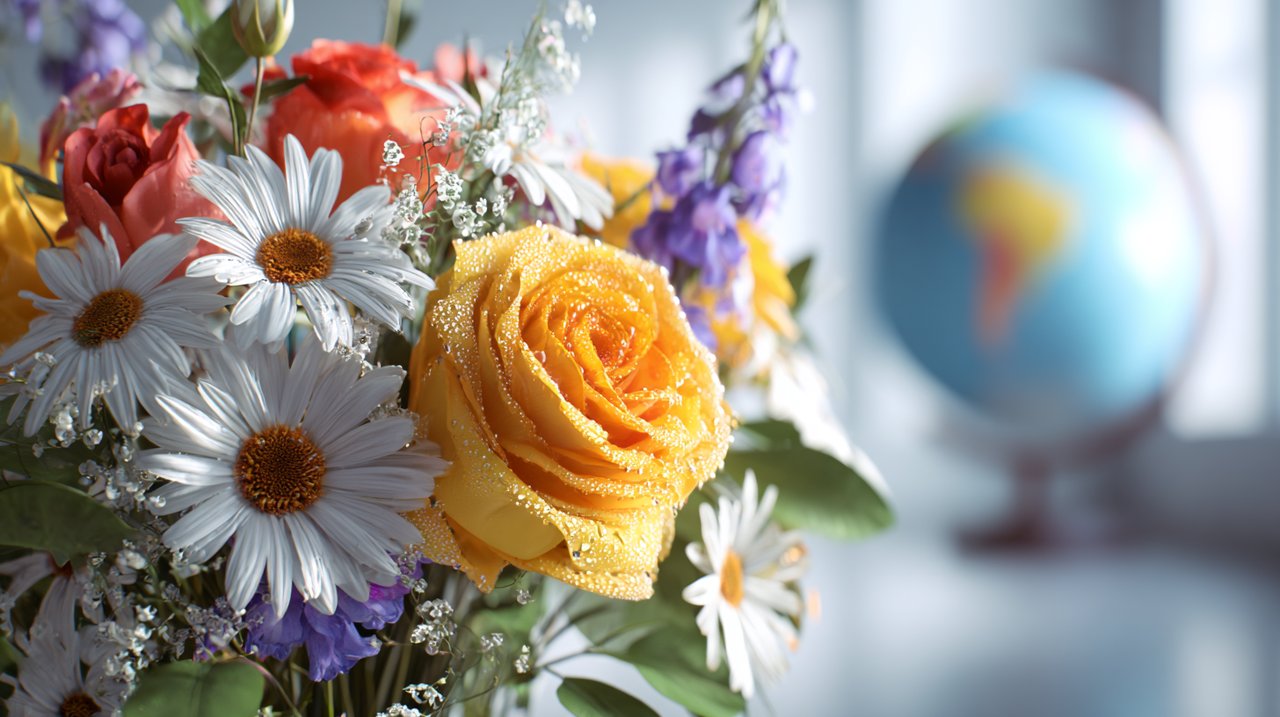Sending flowers across continents is far more than a simple transaction. It’s a powerful bridge of emotion, a silent message that travels thousands of miles. Yet, when this heartfelt journey spans from Australia to China, what seems like a straightforward gesture quickly transforms into a nuanced dance. It demands both logistical precision and a deep, empathetic cultural understanding.
Many find themselves navigating a maze of complexities, unsure if their thoughtful gift will truly resonate or even arrive intact. This guide is designed to cut through that uncertainty. We’ll explore the entire process through a unique “dual lens,” harmonizing Australia’s practical approach with China’s rich cultural tapestry.
Each step is crafted to empower you with the essential knowledge, transforming potential pitfalls into opportunities for a truly memorable and meaningful delivery. Let’s make sure your message is not just sent, but beautifully received.

The Dual Lens: Bridging Cultural Expectations and Logistical Realities
Sending flowers internationally is never a “one-size-fits-all” endeavor. The true success of your gesture hinges on understanding the fundamental differences between domestic and international practices, especially when comparing Australia and China.
Consider this core distinction: While Australia’s flower gifting culture often prioritizes aesthetic appeal and general sentiment, China’s traditions are deeply steeped in symbolism. Here, every color, number, and flower type carries specific, often powerful, meanings. It’s not just about beauty; it’s about the message.
This dual perspective is absolutely paramount. It means going beyond simply finding a service that delivers. Instead, you need one that truly understands local Chinese customs and can expertly navigate unique import regulations. Ignoring either the cultural or the logistical dimension risks your thoughtful gift being misinterpreted or, worse, failing to arrive.
Our approach is to illuminate these two distinct worlds, showing precisely how they intersect and where careful consideration is required. This ensures your message is not just delivered, but perfectly conveyed and appreciated.
Step 1: Researching Reputable International Flower Delivery Services
Selecting a reliable service is the foundational step, literally bridging the vast geographical distance. This choice is critical, as it directly dictates the reliability, cost, and ultimate success of your delivery. You primarily face two distinct options, each with its own advantages and considerations:
Global Aggregators: Think of names like Interflora or FTD. They operate through extensive international networks, offering convenience and often familiar branding for Australian senders. However, their reliance on local subcontractors in China can sometimes mean less direct control over the specific florist chosen. This might impact the freshness of local stock or the depth of cultural insight applied to your order.
Local Chinese Florists with International Portals: These providers often offer direct sourcing, which typically translates to fresher flowers and more competitive pricing. Their inherent understanding of local customs and logistical intricacies is a significant advantage. The trade-off for Australian senders might be less familiar payment methods or customer support operating on different time zones.
When evaluating providers, prioritize those with a proven track record of successful deliveries to mainland China. Scrutinize their clear pricing structures, transparent delivery policies, and the robustness of their customer support. Crucially, verify their ability to manage customs declarations and ensure flower freshness upon arrival.
A service offering local customer support within China can be invaluable for resolving last-minute delivery issues. This offers a distinct advantage over those relying solely on Australian-based teams. This careful selection, weighing convenience against localized expertise, forms the operational bedrock of your thoughtful gesture.
Step 2: Navigating China’s Flower Etiquette and Symbolism
In China, a flower is far more than just something beautiful; it functions as a carrier of specific meaning, a silent orator. This cultural context is absolutely critical. What might be considered a beautiful bouquet in Australia could, without proper insight, convey an unintended message in China.
The core principle here is profound: “The gift is not in the thing itself, but in its meaning.” Ignoring this can inadvertently undermine your gesture.
Consider the stark contrast in symbolism:
While white flowers are commonly associated with weddings and purity in Western cultures, they are traditionally linked with funerals and mourning in China. This makes them entirely unsuitable for celebratory occasions.
Conversely, red flowers, symbolizing luck, prosperity, and happiness, are almost universally well-received. They are particularly popular for events like Chinese New Year, weddings, or business openings.
Yellow often denotes friendship, while pink can signify gentleness and admiration.
The symbolism extends even to the number of stems. In China, odd numbers are generally preferred over even ones, with notable exceptions for 8 (symbolizing prosperity) and 9 (representing longevity).
It is crucial to steer clear of chrysanthemums, which are exclusively reserved for funerals. Also, be cautious with certain lilies, which can carry death symbolism depending on their context. Opting for roses, orchids, or peonies is often a safe and cherished choice, as these blooms carry universally positive connotations of love, beauty, and wealth.
This analytical comparison of Australian and Chinese floral meanings underscores the necessity of the “dual lens.” It ensures your message is not just delivered, but accurately understood and appreciated.

Step 3: Understanding Customs, Regulations, and Delivery Constraints
Shipping live plants across international borders involves a complex web of regulations. These are designed to prevent the spread of pests and diseases. This step is critical because non-compliance can lead to confiscation, significant delays, or even the complete failure of your delivery.
Unlike domestic deliveries within Australia, sending flowers to China typically necessitates phytosanitary certificates and strict adherence to specific import guidelines. While reputable florists generally manage these complexities on your behalf, it is crucial to confirm they handle all necessary documentation, including customs declarations and potential duties.
This highlights a significant logistical divergence: international shipping to China demands a far greater degree of regulatory oversight compared to simpler Australian domestic shipping.
Furthermore, consider the recipient’s address with meticulous care:
Delivery to remote rural areas or certain restricted zones within China might be impossible or incur substantial surcharges.
Always provide a local Chinese phone number for the recipient. Delivery drivers frequently call ahead to confirm availability and navigate complex residential or business access protocols.
Be acutely aware of public holidays in China, such as Chinese New Year or National Day. These periods can cause significant delays or even temporary cessation of deliveries, making timely arrival challenging.
This detailed understanding of unique Chinese logistical realities, contrasted with simpler Australian domestic norms, is paramount for successful international flower delivery.
Step 4: Crafting Your Order: Personalization and Payment
Once you’ve chosen your service and assimilated the cultural nuances, the next critical step is placing your order. Beyond simply selecting the appropriate blooms, personalization adds immense value to your gesture, transforming a mere transaction into a truly heartfelt message.
A handwritten card, ideally translated into Mandarin, will convey a deeply personal touch. This bridges the linguistic gap and amplifies your thoughtfulness in a culturally resonant way. It shows you’ve gone the extra mile.
When considering payment, ensure the service accommodates your preferred method. Many international florists now support a variety of payment gateways, including international credit cards and PayPal. Some, particularly those with a strong local presence in China, may also offer local Chinese payment platforms like Alipay or WeChat Pay, providing additional flexibility.
This comparison of payment options highlights the adaptation required for international transactions, moving beyond standard Australian payment methods.
Finally, double-check all recipient details with rigorous precision. This includes:
- Their full name
- The complete address (encompassing province, city, district, street, building number, and apartment number)
- Most critically, a local Chinese contact number
A minor error here can lead to significant delays or even a failed delivery, negating all your careful planning and the intended sentiment. This meticulous attention to detail, particularly regarding the specific structure of Chinese addresses and the necessity of a local contact, is a cornerstone of the “dual lens” approach.
Step 5: Tracking Your Gesture: From Australia to China
After placing your order, the journey of your flowers truly commences. Reliable tracking is paramount for your peace of mind, allowing you to monitor the progress of your delivery across continents. This step is critical because international shipments inherently involve longer transit times and a greater potential for unforeseen delays or complex customs clearances compared to domestic Australian deliveries.
Most reputable services will provide a tracking number or an online system to check your order’s status. Familiarize yourself with the tracking interface and understand what each status update signifies. If you observe any unusual delays or issues, proactively contact the customer support of your chosen florist.
Having the recipient’s local contact information readily available can also be crucial. This enables the florist to coordinate directly with them for a smooth hand-off, especially if there are access issues or delivery schedule changes.
The ability to track ensures you remain informed rather than left to wonder. It empowers you to act if needed, confirming your thoughtful gesture reaches its destination as intended. This continuous oversight, amplified in importance for the extended journey from Australia to China, provides transparency and reinforces the reliability of your chosen service.

Sending flowers from Australia to China is truly a journey that transcends mere logistics; it’s an act of cultural diplomacy and heartfelt connection. By adopting the “dual lens” approach—meticulously researching services, respecting cultural symbolism, navigating regulations, and diligently tracking your order—you transform a potentially daunting task into a seamless expression of affection.
This guide has provided you with the comprehensive framework to make informed decisions at every turn. Embrace the insights shared, and let your thoughtful gesture serve as a beautiful bridge between two distant lands. Ready to send your message? Your careful planning ensures it will be received with the warmth and understanding it deserves.
💡 Frequently Asked Questions
Sending flowers across continents is more than just a transaction; it's an emotional gesture that requires understanding both logistical aspects and cultural nuances, especially the symbolism of flowers in China.
You can choose between global aggregators like Interflora, which offer convenience, or local Chinese florists that understand customs and provide fresher flowers. It's essential to check their track record, pricing structure, and customer support.
In China, flowers carry specific meanings. For example, red flowers symbolize luck and happiness, while white flowers are associated with funerals. It's crucial to select blooms that convey the desired message.
Sending flowers to China requires adherence to strict import regulations, including obtaining phytosanitary certificates. Ensure your florist manages all necessary documentation to avoid delays or confiscation.
You can personalize your delivery by including a handwritten card, preferably translated into Mandarin. Additionally, ensure all recipient details, such as their local contact number and complete address, are accurate.

